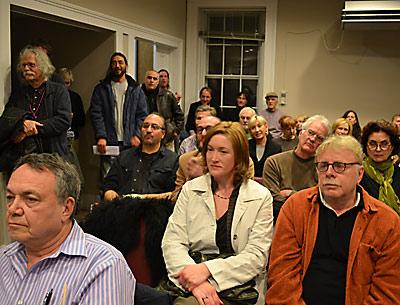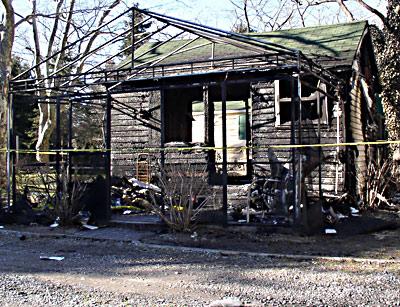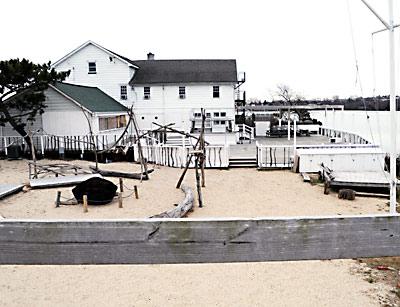Structure or Sculpture?
Structure or Sculpture?

It was standing-room only Tuesday night in Sag Harbor as the village’s zoning board of appeals met once again to consider the case of “Legs,” the 16-foot-tall fiberglass sculpture created by Larry Rivers and owned by Janet Lehr and Vered, art collectors and partners in East Hampton’s Vered Gallery.
The work has stood on the side of the couple’s Madison Street house, a former Baptist church, since 2008, when a building inspector first declared that it was in fact an “accessory structure,” and as such needed several variances. Not only is it 1.1 feet higher than allowed but it stands just a foot from the neighboring property, where 35 feet are required, and violates the village’s pyramid law.
Whether because the artist’s body of work is well known both here and abroad, or because Sag Harbor is home to many members of the metropolitan media, the saga of “Legs” has been a cause celebre since last May, when the Z.B.A. denied its owners’ application to let it stay; allowing them, however, to reapply. Several videocameras were spotted at Tuesday’s emotional hearing.
Richard (Andy) Hammer, the couple’s attorney, presented the board with written and online petitions with 430 signatures favoring the necessary variances and another 62 written or e-mailed letters in support. Mr. Hammer began his argument by stating that the business of an agency such as the Z.B.A. was to regulate the use of a property to insure the health, welfare, and safety of the community, none of which pertained to “Legs,” which he said represented a vehicle “for the exercise of freedom of speech and expression.” When the audience burst into loud applause upon hearing this, the board’s acting chairman, Brendan Skislock, asked them to tone it down. Gayle Pickering, the chairwoman, was not present, and another member, Michael Bromberg, recused himself because he has relatives who live near Vered and Ms. Lehr’s house, leaving only three Z.B.A. members to hear the case.
Mr. Skislock also discouraged Mr. Hammer from discussing the differences between a structure and a sculpture, saying it was in the applicants’ best interest to focus on the requested special-exception variance.
Assemblyman Fred W. Thiele Jr., who lives in Sag Harbor and is the village attorney, also urged Mr. Hammer to focus on the variance. “It is a structure,” said Mr. Thiele, as he has said for the past three years. “The last thing anyone wants is for government to determine what is art, and what is not.”
Mr. Hammer shot back that the Sag Harbor community supports artistic expression, and said its zoning regulations were not created to stifle speech or to regulate art. He called “Legs” “a vital community asset, the value of which transcends this board, applicants, and structure.”
“If we are looking at this as a sculpture,” said Mr. Skislock, “I don’t think it has any place on the zoning board of appeals. What we have to do is concentrate on it as a structure. Focusing on that, we can draw decisions as far as setbacks.”
As a structure, then, would “Legs” affect the health, welfare, and safety of the community? Mr. Hammer again asked.
The house itself, he told the board, stands just two or three feet from the property line. After it was a church it was an art institute and a gallery, and there is no conforming location on the property for the Rivers piece.
“The building is pre-existing and nonconforming?” asked Mr. Skislock. Yes, said Mr. Hammer, who called it a cornerstone of the community. Together with “Legs,” he said, it combined both history and the contemporary, exemplifying Sag Harbor’s eclectic character. “It is just not the same as a garage setback,” he insisted.
Mr. Skislock noted the board’s concern that a precedent might be set were the variance to be approved, with the possibility of hundreds of sculptures popping up around the village — perhaps, he said, a giant ice cream cone.” You are asking us to rethink our idea of what Sag Harbor should look like,” said Anthony Hagen, a member of the board. “Notwithstanding the audience who stands in favor, I don’t think it represents the community of Sag Harbor.”
Mr. Hammer disagreed. “I don’t think you are going to find 150 people who have similar character” in the village, he said, going on to call Vered and Ms. Lehr “visionary people compelled to express themselves.”
Just two voices were raised in opposition to the variance. Jennifer Hauser’s was one. She described herself as an art lover who owns two houses that face “Legs.” Larry Rivers was “brilliant,” Ms. Hauser allowed, but “let’s not set a precedent that we will regret later. I think it is an advertisement and a merchandising model, and it is illuminated all night.”
Charles McCarron, who lives on Noyac Road and owns the house next door to Vered’s and Ms. Lehr’s, also stood to oppose a variance. Mr. McCarron, who was one of the first and loudest to speak out against “Legs,” said, “I don’t like them, Jennifer doesn’t like them.”
Mr. Skislock interrupted. “We’re viewing it as a structure,” he said. “It doesn’t matter who likes it and who doesn’t.”
“By saying that this is a structure, you are inadvertently saying that it is not art,” said an emotional David Joel, the executive director of the Larry Rivers estate and a Sag Harbor resident. The work “was commissioned in 1994 and documented as art for 18 years,” he said. “If it’s art, then you shouldn’t be before this board,” replied Mr. Hagen. “This board can only look at structures.”
“It shouldn’t come before you, maybe you should recognize that, I say that with respect,” said Mr. Hammer. “You interpret code, you could simply decide [that] it’s art, it’s not a structure. It is fully within your ability.”
The Z.B.A. will not hand down a decision until next month, which allows 10 days for new public comment and for Ms. Pickering’s input. The board’s next meeting is on March 20.








